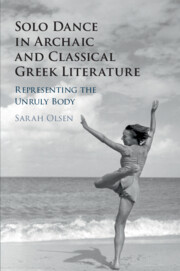Book contents
- Solo Dance in Archaic and Classical Greek Literature
- Solo Dance in Archaic and Classical Greek Literature
- Copyright page
- Dedication
- Contents
- Figures
- Acknowledgments
- Notes on Texts, Abbreviations, and Style
- Introduction
- Chapter 1 The Fantastic Phaeacians
- Chapter 2 Io’s Dance
- Chapter 3 Dance at Work
- Chapter 4 Dance and Dissonance
- Chapter 5 Staging Madwomen
- Chapter 6 Agency, Narrative, and the Dancing Girl
- Chapter 7 Dance History
- Conclusion
- Bibliography
- Index Locorum
- General Index
Chapter 4 - Dance and Dissonance
The Innovative Choreography of Aristophanes’ Wasps
Published online by Cambridge University Press: 30 November 2020
- Solo Dance in Archaic and Classical Greek Literature
- Solo Dance in Archaic and Classical Greek Literature
- Copyright page
- Dedication
- Contents
- Figures
- Acknowledgments
- Notes on Texts, Abbreviations, and Style
- Introduction
- Chapter 1 The Fantastic Phaeacians
- Chapter 2 Io’s Dance
- Chapter 3 Dance at Work
- Chapter 4 Dance and Dissonance
- Chapter 5 Staging Madwomen
- Chapter 6 Agency, Narrative, and the Dancing Girl
- Chapter 7 Dance History
- Conclusion
- Bibliography
- Index Locorum
- General Index
Summary
Chapter Four turns to Aristophanes’ Wasps, wherein the playwright’s depiction of Philocleon as a renegade komast and irrepressibly unruly dancer in Wasps provocatively questions the socializing force of the kōmos as well as the mimetic force of dance itself. This chapter begins by considering the kōmos more broadly as a space for solo dance, especially male solo dance. I argue that Greek literature persistently imagines the kōmos (and even the symposium) as a kind of chorus, drawing the potentially unruly expression associated with these spaces into the socializing orbit of choreia. In the second half of the chapter, I show that Aristophanes exploits the unruly potential of komastic dance to represent Philocleon as a character who repeatedly breaks free of both social and generic constraints, even to the point of sidelining the chorus itself. In the final scenes of the play, I suggest that Aristophanes probes the ability of dance to function as a stable form of representation and problematizes the place of dance within both drama and society.
- Type
- Chapter
- Information
- Solo Dance in Archaic and Classical Greek LiteratureRepresenting the Unruly Body, pp. 100 - 128Publisher: Cambridge University PressPrint publication year: 2020

